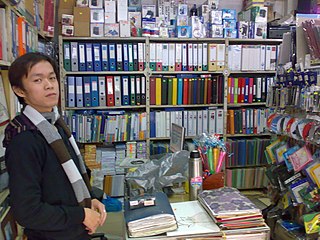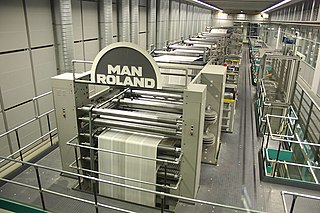
In computing, a printer is a peripheral device which makes a persistent human-readable representation of graphics or text on paper. The first computer printer designed was a mechanically driven apparatus by Charles Babbage for his difference engine in the 19th century; however, his mechanical printer design was not built until 2000. The first electronic printer was the EP-101, invented by Japanese company Epson and released in 1968. The first commercial printers generally used mechanisms from electric typewriters and Teletype machines. The demand for higher speed led to the development of new systems specifically for computer use. In the 1980s were daisy wheel systems similar to typewriters, line printers that produced similar output but at much higher speed, and dot matrix systems that could mix text and graphics but produced relatively low-quality output. The plotter was used for those requiring high quality line art like blueprints.
Electronic paper and e-paper, also sometimes electronic ink or e-ink, are display devices that mimic the appearance of ordinary ink on paper. Unlike conventional backlit flat panel displays that emit light, electronic paper displays reflect light like paper. This may make them more comfortable to read, and provide a wider viewing angle than most light-emitting displays. The contrast ratio in electronic displays available as of 2008 approaches newspaper, and newly (2008) developed displays are slightly better. An ideal e-paper display can be read in direct sunlight without the image appearing to fade.

Ink is a liquid or paste that contains pigments or dyes and is used to color a surface to produce an image, text, or design. Ink is used for drawing or writing with a pen, brush, or quill. Thicker inks, in paste form, are used extensively in letterpress and lithographic printing.

The CMYK color model is a subtractive color model, used in color printing, and is also used to describe the printing process itself. CMYK refers to the four inks used in some color printing: cyan, magenta, yellow, and key.

Inkjet printing is a type of computer printing that recreates a digital image by propelling droplets of ink onto paper, plastic, or other substrates. Inkjet printers are the most commonly used type of printer, and range from small inexpensive consumer models to expensive professional machines.

Invisible ink, also known as security ink, is a substance used for writing, which is invisible either on application or soon thereafter, and can later be made visible by some means. Invisible ink is one form of steganography.

Stationery is a mass noun referring to commercially manufactured writing materials, including cut paper, envelopes, writing implements, continuous form paper, and other office supplies. Stationery includes materials to be written on by hand or by equipment such as computer printers.

Ink wash painting, or sumi-e (墨絵), is a type of East Asian brush painting that uses black ink – as used in East Asian calligraphy – in different concentrations. Emerging in Tang dynasty China (618–907), it, and associated stylistic features, overturned earlier, more realistic techniques. These associated features include a preference for shades of black over variations in colour, and an emphasis on brushwork and the perceived "spirit" or "essence" of a subject over direct imitation. It flourished in the Song dynasty (960–1279), as well as Japan after it was introduced by Zen Buddhist monks in the 14th century.

The Bureau of Engraving and Printing (BEP) is a government agency within the United States Department of the Treasury that designs and produces a variety of security products for the United States government, most notable of which is Federal Reserve Notes for the Federal Reserve, the nation's central bank. In addition to paper currency, the BEP produces Treasury securities; military commissions and award certificates; invitations and admission cards; and many different types of identification cards, forms, and other special security documents for a variety of government agencies. The BEP does not produce coins; all coinage is produced by the United States Mint. With production facilities in Washington, D.C., and Fort Worth, Texas, the Bureau of Engraving and Printing is the largest producer of government security documents in the United States.

Offset printing is a commonly used printing technique in which the inked image is transferred from a plate to a rubber blanket, then to the printing surface. When used in combination with the lithographic process, which is based on the repulsion of oil and water, the offset technique employs a flat (planographic) image carrier on which the image to be printed obtains ink from ink rollers, while the non-printing area attracts a water-based film, keeping the non-printing areas ink-free. The modern "web" process feeds a large reel of paper through a large press machine in several parts, typically for several metres, which then prints continuously as the paper is fed through.

Security printing is the field of the printing industry that deals with the printing of items such as banknotes, cheques, passports, tamper-evident labels, security tapes, product authentication, stock certificates, postage stamps and identity cards. The main goal of security printing is to prevent forgery, tampering, or counterfeiting. More recently many of the techniques used to protect these high-value documents have become more available to commercial printers whether they are using the more traditional offset and flexographic presses or the newer digital platforms. Businesses are protecting their lesser-value documents such as transcripts, coupons and prescription pads by incorporating some of the features listed below to ensure that they cannot be forged or that alteration of the data cannot occur undetected.

Rotogravure is a type of intaglio printing process, which involves engraving the image onto an image carrier. In gravure printing, the image is engraved onto a cylinder because, like offset printing and flexography, it uses a rotary printing press. Once a staple of newspaper photo features, the rotogravure process is still used for commercial printing of magazines, postcards, and corrugated (cardboard) and other product packaging.

Pounce is a fine powder, most often made from powdered cuttlefish bone, that was used both to dry ink and to sprinkle on a rough writing surface to make it smooth enough for writing. This last was certainly needed if the paper came "unsized", that is, lacking the thin gelatinous material used to fill the surface of the paper and make it smooth enough for writing with a quill or a steel nib. It was also used to prepare the surface when drafting with Rapidiograph pens on mylar, a common drafting medium in the late twentieth century.

Kodak EasyShare is a sub brand of Eastman Kodak Company products identifying a consumer photography system of digital cameras, snapshot thermal printers, snapshot thermal printer docks, all-in-one inkjet printers, accessories, camera docks, software, and online print services. The brand was introduced in 2001. The brand is no longer applied to all-in-one inkjet printers or online printing services. Thermal snapshot printers and printer docks product lines have been discontinued. In 2012, Kodak stopped manufacturing and selling all digital cameras and photo frames.

E Ink is a popular type of electronic paper (e-paper) display technology, characterized by high visibility and contrast, a wide viewing angle and low power requirements. The technology has been commercialized by the E Ink Corporation, which was co-founded in 1997 by MIT undergraduates J.D. Albert & Barrett Comiskey, MIT Media Lab professor Joseph Jacobson, Jerome Rubin and Russ Wilcox.

A technical pen is a specialized instrument used by an engineer, architect, or drafter to make lines of constant width for architectural, engineering, or technical drawings. "Rapidograph" is a trademarked name for one type of technical pen. Technical pens use either a refillable ink reservoir or a replaceable ink cartridge.

Blotting paper, sometimes called bibulous paper, is a highly absorbent type of paper or other material. It is used to absorb an excess of liquid substances from the surface of writing paper or objects. Blotting paper referred to as bibulous paper is mainly used in microscopy to remove excess liquids from the slide before viewing. Blotting paper has also been sold as a cosmetic to aid in the removal of skin oils and makeup.
Deinking is the industrial process of removing printing ink from paperfibers of recycled paper to make deinked pulp.

The environmental impact of paper is significant, which has led to changes in industry and behaviour at both business and personal levels. With the use of modern technology such as the printing press and the highly mechanized harvesting of wood, disposable paper became a relatively cheap commodity, which led to a high level of consumption and waste. The rise in global environmental issues such as air and water pollution, climate change, overflowing landfills and clearcutting have all lead to increased government regulations. There is now a trend towards sustainability in the pulp and paper industry as it moves to reduce clear cutting, water use, greenhouse gas emissions, fossil fuel consumption and clean up its impacts on local water supplies and air pollution.
The surface chemistry of paper is responsible for many important paper properties, such as gloss, waterproofing, and printability. Many components are used in the paper-making process that affect the surface.

















